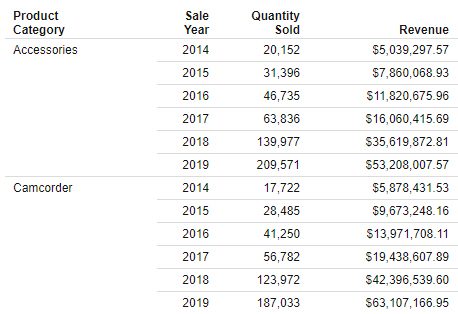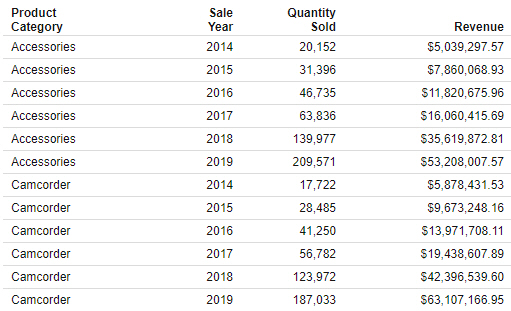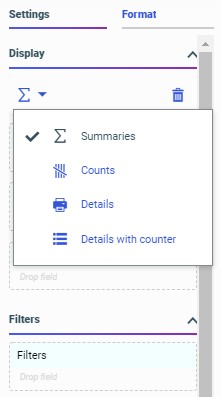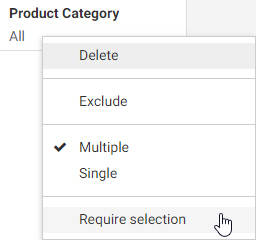|
How to: |
You can create reports in a visualization in WebFOCUS Designer similar to the way in which you create charts. Reports allow you to communicate information at a high level of detail using a familiar tabular format. You can create a stand-alone report in a visualization, or combine multiple reports in a page.
You can create a report by creating new content in a visualization and changing the content type to a report using the Content picker. The report options in the Content picker are shown in the following image.

Three report layout options are available: a standard, tabbed report in which repeating sort values are only displayed once, a grid in which sort values repeat so that all cells of the report are filled. The third option creates a data grid, which is a type of chart that resembles a tabbed report.
The following image shows a report using the standard report layout.

The following image shows a report using the grid layout.

To populate the report, select measures and dimensions from the Resources panel with the Fields tab selected from the sidebar. The Resources panel displays the fields that were populated from your data source. You can add fields to your report in the following ways:
- Drag a field from the Fields tab into your content.
- Double-click a field in the Fields tab.
- Drag a field from the Fields tab into a bucket.
- Right-click a field on the Fields tab and click Add to report.
When you add a field to your report, the canvas updates to display the values in it.
You can define the rows and columns in a report by adding fields to the Rows and Column Groups buckets, respectively. Typically, these are dimension fields. The values in these fields are used to sort the report.
You can display aggregated values in a report by adding fields to the Summaries bucket. This bucket is usually used to display values for measure fields. The Summaries bucket displays by default, but you can change the bucket by selecting a different display option. The available display options are shown in the following image.

The Summaries and Counts options provide aggregated measure values for each sort value, that is, each row or column, in the report. The Details and Details with counter display options, on the other hand, provide a complete list of every value for the selected field or fields.
Once you have added fields to the report, you can format it to enhance its appearance or style. For example, you might want to add a header and footer to identify the information on each page of the report, or use a report template to modify the layout. You can also click the Format tab to apply a theme or change the output format of the report and style different areas of the report.
On the Format tab, select an option from the quick access menu on the Format tab to select the area that you want to style. By default, General is selected. Styling changes made here affect the entire report. Other areas that you can style include different columns, totals, and headers and footers. You can select different options to style only the titles or data values in a report, or both, and for certain areas you can select which fields your styling is applied to. You can change the typeface, size, style, alignment, and color of the text in different areas of a report, and the background color and margins of cells.
You can filter a report using prompted or static filters. To create a prompted filter, drag a field from the Fields tab to the Filter toolbar. A menu appears, allowing you to select default filter values. When a report with prompted filters is added to a visualization assembled from existing content, you can create filter controls to allow users to select their own filter values at run time. When creating a report, you can also require user selection for a prompted filter, so that the report does not run until the user makes a filter selection, by right-clicking the filter in the toolbar and clicking Require selection, as shown in the following image.

Static filters, on the other hand, do not allow user selection at run-time. They allow you to apply consistent filters to the report that cannot be modified at run time. To create a static filter, drag a field from the Fields tab to the Filters bucket, then specify filter values in the Add Filter dialog box.